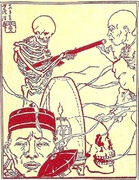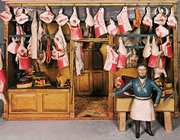
Stuffed rattlesnake with Miller’s Antiseptic Oil.
These days, “snake oil” is synonymous with quackery, the phoniest of phony medicines. A “snake oil salesman” promises you the world, takes your money, and is long gone by the time you realize the product in your hands is completely worthless. But get this: The original snake oil actually worked. Save this one for the next cocktail party; it will blow your friends’ minds.

Performers from the Little Doc Robert’s Old Time Medicine Show.
In the 1860s, Chinese laborers immigrated to the United States to work on the Transcontinental Railroad. At night, they would rub their sore, tired muscles with ointment made from Chinese water snake (Enhydris chinensis), an ancient Chinese remedy they shared with their American co-workers.
A 2007 story in Scientific American explains that California neurophysiology researcher Richard Kunin made the connection between Chinese water snakes and omega-3 fatty acids in the 1980s.

A Clark Stanley label.
“Kunin visited San Francisco’s Chinatown to buy such snake oil and analyze it. According to his 1989 analysis published in the Western Journal of Medicine, Chinese water-snake oil contains 20 percent eicosapentaenoic acid (EPA), one of the two types of omega-3 fatty acids most readily used by our bodies. Salmon, one of the most popular food sources of omega-3s, contains a maximum of 18 percent EPA, lower than that of snake oil.”
However, it wasn’t until several years after Kunin’s research that American scientists discovered that omega-3s are vital for human metabolism. Not only do they sooth inflammation in muscles and joints, but also, they can help “cognitive function and reduce blood pressure, cholesterol, and even depression.”
So why does snake oil have such a bad rap?
Well, hucksters that sold patent or proprietary medicine caught wind of the miraculous muscle-soothing powers of snake oil. Naturally, they decided to sell their own versions of snake oil—but it was just much easier to forgo using actual snakes.
In the dry and dusty 19th century Wild West, Chinese water snakes were hard to come by. Already, to give their remedies credibility, these companies—in particular, the Kickapoo Indian Medicine Company—claimed that their recipes came from Native American healers.
In the last dozen years or so, omega-3 supplements, oils, and creams have made a comeback in big way.
As it turns out the Choctaws and other tribes did use rattlesnake grease to alleviate pain from rheumatoid arthritis—even though, according to Kunin’s research, earth-dwelling rattlesnakes have far less omega-3s (8.5 percent EPA) than oily water-dwelling snakes. So the charlatans claimed to make their cure-all out of the most fearsome snake most Americans ever encountered: the rattlesnake.
Even better, the rattlesnake could be used to heighten the danger and excitement during their pitches. To sell people on their products, these companies toured the West with elaborate carnival-like “medicine shows” often featuring live music, puppetry, acrobatics, blackface performers, and sideshow acts. The medicine show always culminated with a dramatic demonstration of the remedy “healing” audience members, usually “shills” placed in the crowd by the company.
Rattlesnake wranglers became hugely popular gimmicks, as they would appear to slaughter a hisser in front of a crowd and then pretend to extract the oil from its body to make a liniment that could cure everything from measles to typhoid fever.
 The most famous of these was a cowboy named Clark Stanley, also known as The Rattlesnake King, who said he got his Snake Oil Liniment formula from a Moki Pueblo tribesman. Wearing colorful Western garb, he’d captivate crowds, like the one at the 1893 World’s Columbian Exposition in Chicago, as he battled rattlers before their eyes.
The most famous of these was a cowboy named Clark Stanley, also known as The Rattlesnake King, who said he got his Snake Oil Liniment formula from a Moki Pueblo tribesman. Wearing colorful Western garb, he’d captivate crowds, like the one at the 1893 World’s Columbian Exposition in Chicago, as he battled rattlers before their eyes.
Stanley’s Snake Oil Liniment had many imitators, including Miller’s Antiseptic Oil and Lincoln Oil. Eventually people became wary of these “snake oil salesmen” and so the hucksters started putting their names and pictures on their bottle labels as a guarantee of their products.

A bottle of rattlesnake oil.
Still, the tide was turning against patent medicine at the turn of the century, as more and more American doctors began to subscribe to the Germ Theory of Disease posed by Robert Koch and Louis Pasteur. Then in 1905, Collier’s magazine published a scathing article indicting patent medicine pushers as fraudsters who sold often poisonous products. The public outrage led to the Pure Food and Drug Act of 1907.
A shipment of Clark Stanley’s Snake Oil Liniment was seized by the U.S. government in 1917 and studied by scientists. Their research revealed that it contained mineral oil, red pepper (which warms the skin), traces of turpentine or camphor (for a medicine smell), and just 1 percent of fatty oil, likely from cattle. But it contained not one ounce of snake oil—rattlesnake, water snake, or otherwise.
It wasn’t long before other “snake oils” started putting their true ingredients on the label like Old Fashioned Snake Oil, produced by C.F. Sams of Durham, N.C., which contained mustard oil, pine oil, petroleum oil, paprika, camphor gum, and oil of wintergreen. Others, like Miller’s, marked their bottles with phrases like “known as snake oil” or “for years called snake oil but does not contain snake oil.”
That marked the beginning of the end for medicine-show hucksters. But was it the end for snake oil? Not entirely. True Chinese water snake oil has always been available in most urban Chinatowns. But in the last dozen years or so, omega-3 supplements, oils, and creams (often made from fish) have made a comeback in big way, available not only at health food stores, but also at your most respectable corner pharmacy. How do you like that?
(Top image of performers from the Little Doc Robert’s Old Time Medicine Show from SideShowWorld.com; stuffed rattlesnake with Miller’s Antiseptic Oil and former snake oil collection from The Skeptiseum.)
Don’t miss Lisa’s conversation with KGO-AM 1810’s Michael Finney on his June 4, 2011, edition of “Consumer Talk.” Listen here.



 Baby's First Butcher Shop, Circa 1900
Baby's First Butcher Shop, Circa 1900
 How Collecting Opium Antiques Turned Me Into an Opium Addict
How Collecting Opium Antiques Turned Me Into an Opium Addict Baby's First Butcher Shop, Circa 1900
Baby's First Butcher Shop, Circa 1900 Mummies and Monkey Skulls: 'Oddities' Host Ryan Matthew Cohn on Creepy Antiques
Mummies and Monkey Skulls: 'Oddities' Host Ryan Matthew Cohn on Creepy Antiques PharmacyThe neighborhood drugstore, featuring a soda fountain and lunch counter, be…
PharmacyThe neighborhood drugstore, featuring a soda fountain and lunch counter, be… Medicine BottlesIn medieval Europe, apothecaries and alchemists appealed to their ailing cu…
Medicine BottlesIn medieval Europe, apothecaries and alchemists appealed to their ailing cu… Mari Tepper: Laying it on the Line
Mari Tepper: Laying it on the Line Nice Ice: Valerie Hammond on the Genteel Charm of Vintage Canadian Costume Jewelry
Nice Ice: Valerie Hammond on the Genteel Charm of Vintage Canadian Costume Jewelry How Jim Heimann Got Crazy for California Architecture
How Jim Heimann Got Crazy for California Architecture Modernist Man: Jock Peters May Be the Most Influential Architect You've Never Heard Of
Modernist Man: Jock Peters May Be the Most Influential Architect You've Never Heard Of Meet Cute: Were Kokeshi Dolls the Models for Hello Kitty, Pokemon, and Be@rbrick?
Meet Cute: Were Kokeshi Dolls the Models for Hello Kitty, Pokemon, and Be@rbrick? When the King of Comedy Posters Set His Surreal Sights on the World of Rock 'n' Roll
When the King of Comedy Posters Set His Surreal Sights on the World of Rock 'n' Roll How One Artist Makes New Art From Old Coloring Books and Found Photos
How One Artist Makes New Art From Old Coloring Books and Found Photos Say Cheese! How Bad Photography Has Changed Our Definition of Good Pictures
Say Cheese! How Bad Photography Has Changed Our Definition of Good Pictures Middle Earthenware: One Family's Quest to Reclaim Its Place in British Pottery History
Middle Earthenware: One Family's Quest to Reclaim Its Place in British Pottery History Fancy Fowl: How an Evil Sea Captain and a Beloved Queen Made the World Crave KFC
Fancy Fowl: How an Evil Sea Captain and a Beloved Queen Made the World Crave KFC
I’m pretty curious how they distinguished fatty acids from cattle and snakes in 1917.
http://www.collectorsweekly.com/stories/18827-pocket-watch-movement-shipping-cases-and?in=user
I have on CW a glass “pocket watch” attributed to a snake oil salesman scam. Info is on the posting.
It’s not only snake oil that got a bad name but turned out to have some level of effectiveness. The placebo itself is finally getting its due!
In the book, “The Emperor’s New Drugs” a medical researcher who’s name I can’t remember (I’m just about finished with the book now), shows how the so-called miracle mental illness drugs like Prozac and Effexor, et al, have actually testing no better than placebos in double-blind randomized controlled experiments all over the world!
So who’s really ripping the consumer off? The medicine show barkers or your local psychiatrist and pharmacists? To the tune of BILLIONS of dollars a year!
“I’m pretty curious how they distinguished fatty acids from cattle and snakes in 1917.”
Considering the people they seized it from, I’d say common sense. Or spectroscopes if they were feeling tecchy.
So….snake oil contains Omega 3 fatty acids — that are currently being touted as a cure for everything from hyperactivity to arthritis. What’s really being said here is that snake oil has been institutionalized into the doubtful (and unregulated) world of dietary supplements research and that the ever-profitable circus continues.
kool and informative article!
Oh well … The story by Cynthia Graber, based on what Richard Kunin told her, has really managed to spread the myth of effective Chinese snake oil wide and far. I don’t know if it will ever go away. But I will try.
The tale about the Chinese snake oil has a touch of Dunning-Kruger, too, considering that in order to believe it, never mind to write it, you have to be unaware of a simple historical fact, well known to everyone who has ever studied the subject: Snake oil – actual snake oil made from actual snakes – was a standard treatment in Europe from at least Roman times up until the 19th century.
Since the immigrants from Europe to America didn’t change opinions on the Atlantic, snake oil was as popular among them in the New World as it was in the Old World. But when it began to wane in Europe, it kept strong in what was now USA. Indeed, it was known and used well before Chinese immigrants began to arrive in numbers in the middle of the 19th century (during and due to the Californian Gold Rush and an absolutely devastating war in China).
That’s that about the origin. How about the efficiency? Well, omega–3s are indeed good in our bodies for a number of things … Provided you ingest them. Since snake oil was never used internally, always externally, I don’t know why those good things are considered relevant.
A note about ”hucksters that sold patent or proprietary medicine”. They were certainly numerous, especially from the later part of the 19th century. But lots of people before, during and after them caught snakes on their own, boiled the oil out of them, and used it, as they had always did. Many of them did, after all, know how to take care of themselves; why should they buy expensive and questionable oil when the hills were full of snakes?
A final note about Clark Stanley … That he is the most well known ”snake oil salesman” today show that people are at least as gullible in the 21st century as in the 19th. All ”facts” about him come from his own little booklet, ”The life and adventures of the american cow-boy”. Like when he captivated the crowds in the 1893 Columbian Exposition; if this he did, it’s very strange that not a single person other than Clark Stanley has ever mentioned his show. Or a simple ”fact” like him being born in 1854 in Abilene, Texas, a city founded in 1881.
I don’t know if this will do, but it’s an attempt to put things straight.